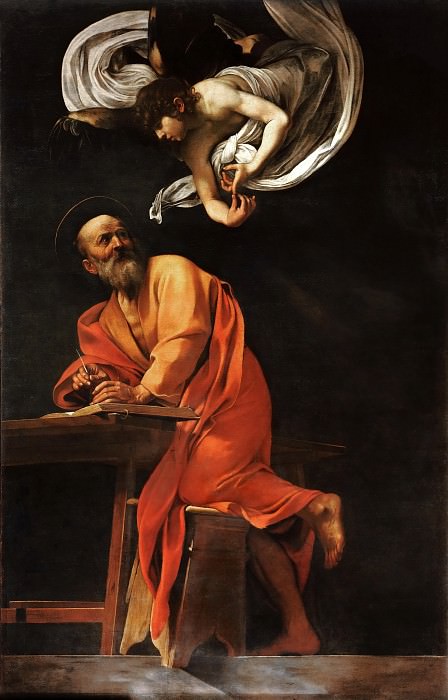Saint Matthew and the Angel Michelangelo Merisi da Caravaggio (1571-1610)
Michelangelo Merisi da Caravaggio – Saint Matthew and the Angel
Edit attribution
Download full size: 3256×5096 px (3,3 Mb)
Painter: Michelangelo Merisi da Caravaggio
The artist turned many times to biblical subjects. One had the impression that while working on the paintings he was looking for something very important for himself. The striking color separation of the mundane and the supreme in his paintings creates an additional contrast between these two spheres. Detailed drawing of figures and objects in the foreground, gives the events a reality. Saint Matthew and the Angel was conceived as part of a painting cycle for the Contarini Chapel.
Description of Michelangelo Merisi da Caravaggio’s Saint Matthew and the Angel
The artist turned many times to biblical subjects. One had the impression that while working on the paintings he was looking for something very important for himself. The striking color separation of the mundane and the supreme in his paintings creates an additional contrast between these two spheres. Detailed drawing of figures and objects in the foreground, gives the events a reality.
Saint Matthew and the Angel was conceived as part of a painting cycle for the Contarini Chapel. The master created two versions. One was rejected as inadequate to the requirements of the canons. The apostle was sitting with a book in his lap, barely able to make out what was written. The angel hovering over the saint was exerting considerable effort in guiding the hand of the writing saint.
This interpretation of the images did not satisfy the church officials at all. And they insisted on a second attempt. The second version differs greatly from the first in composition and emotional message. The size of the canvas was increased.
On a very dark, almost black background the de figures stand out vividly. Matthew listens intently to the angel above his head. The saint’s clothing contrasts with the angel’s snow-white attire. The saint’s posture is very unsteady, but he pays no attention to it, diligently recording the angel’s revelations.
The original of the first version has not survived; there is only a black-and-white reproduction. The fate of the second canvas would also be unenviable, if it were not for art historian Roberto Longhi, who rediscovered them and prepared them for the exhibition of the artist’s work.
Кому понравилось
Пожалуйста, подождите
На эту операцию может потребоваться несколько секунд.
Информация появится в новом окне,
если открытие новых окон не запрещено в настройках вашего браузера.
You need to login
Для работы с коллекциями – пожалуйста, войдите в аккаунт (open in new window).




















You cannot comment Why?
The angel, depicted with muscular form and dynamic movement, is draped in white cloth that billows around it. The angels face is turned towards Matthew, and its hand is gesturing, presumably dictating or inspiring the text that Matthew is recording. The intense realism, characteristic of Caravaggios work, is evident in the musculature of the angel and the weathered features of Saint Matthew. The dramatic use of chiaroscuro, with strong contrasts between light and shadow, imbues the scene with a sense of spiritual intensity and focus.
The subtexts of the painting are rich with theological and psychological depth. The scene portrays the moment of divine inspiration, where human effort (Matthews writing) is infused with heavenly guidance (the angels presence). It speaks to the process of creating sacred texts, emphasizing that scripture is not solely a human endeavor but a collaboration between the divine and the human. Saint Matthews upward gaze and slightly hesitant posture suggest humility and a deep reverence for the divine message he is receiving. The angels active pose and direct engagement with Matthew highlight the tangible nature of divine intervention. The painting can be interpreted as a visual representation of the power of faith and the transformative nature of divine revelation.